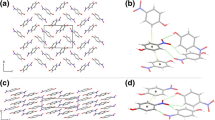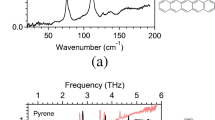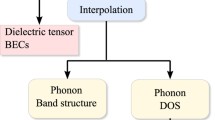Abstract
The low-frequency (terahertz) dynamics of condensed phase materials provide valuable insight into numerous bulk phenomena. However, the assignment and interpretation of experimental results require computational methods due to the complex mode types that depend on weak intermolecular forces. Solid-state density functional theory has been used in this regard with great success, yet the selection of specific computational parameters, namely the chosen basis set and density functional, has a profound influence on the accuracy of predicted spectra. In this work, the role of these two parameters is investigated in a series of organic molecular crystals, in order to assess the ability of various methods to reproduce intermolecular forces, and subsequently experimental terahertz spectra. Specifically, naphthalene, oxalic acid, and thymine were chosen based on the varied intermolecular interactions present in each material. The results highlight that unconstrained geometry optimizations can be used as an initial proxy for the accuracy of interatomic forces, with errors in the calculated geometries indicative of subsequent errors in the calculated low-frequency vibrational spectra, providing a powerful metric for the validation of theoretical results. Finally, the origins of the observed shortcomings are analyzed, providing a basic framework for further studies on related materials.












Similar content being viewed by others
Change history
22 September 2022
A Correction to this paper has been published: https://doi.org/10.1007/s10762-021-00782-x
References
Schweicher, G.; D’Avino, G.; Ruggiero, M. T.; Harkin, D. J.; Broch, K.; Venkateshvaran, D.; Liu, G.; Richard, A.; Ruzié, C.; Armstrong, J.; Kennedy, A. R.; Shankland, K.; Takimiya, K.; Geerts, Y. H.; Zeitler, J. A.; Fratini, S.; Sirringhaus, H. “Chasing the “Killer” Phonon Mode for the Rational Design of Low–Disorder, High–Mobility Molecular Semiconductors”. Adv. Mater., 31 (43), 2019, 1902407.
Zhang, W.; Maul, J.; Vulpe, D.; Moghadam, P. Z.; Fairen-Jimenez, D.; Mittleman, D. M.; Axel Zeitler, J.; Erba, A.; Ruggiero, M. T. “Probing the Mechanochemistry of Metal-Organic Frameworks with Low-Frequency Vibrational Spectroscopy”. J. Phys. Chem. C, 122 (48), 2018, 27442–27450.
Ruggiero, M. T.; Sutton, J. J.; Fraser-Miller, S. J.; Zaczek, A. J.; Korter, T. M.; Gordon, K. C.; Zeitler, J. A. “Revisiting the Thermodynamic Stability of Indomethacin Polymorphs with Low-Frequency Vibrational Spectroscopy and Quantum Mechanical Simulations”. Cryst. Growth Des., 18, 2018, 6513–6520.
Ruggiero, M. T.; Sibik, J.; Orlando, R.; Zeitler, J. A.; Korter, T. M. “Measuring the Elasticity of Poly-L-Proline Helices with Terahertz Spectroscopy”. Angew. Chem. Int. Ed., 55 (24), 2016, 6877–6881.
Delaney, S. P.; Korter, T. M. “Terahertz Spectroscopy and Computational Investigation of the Flufenamic Acid/Nicotinamide Cocrystal”. J. Phys. Chem. A, 119, 2015, 3269–3276.
Allis, D.; Fedor, A.; Korter, T.; Bjarnason, J.; Brown, E. “Assignment of the lowest-lying THz absorption signatures in biotin and lactose monohydrate by solid-state density functional theory”. Chem. Phys. Lett., 440 (4-6), 2007, 203–209.
Neu, J.; Stone, E. A.; Spies, J. A.; Storch, G.; Hatano, A. S.; Mercado, B. Q.; Miller, S. J.; Schmuttenmaer, C. A. “Terahertz Spectroscopy of Tetrameric Peptides”. J. Phys. Chem. Lett., 10, 2019, 2624–2628.
Tan, N. Y.; Ruggiero, M. T.; Orellana-Tavra, C.; Tian, T.; Bond, A. D.; Korter, T. M.; Fairen-Jimenez, D.; Axel Zeitler, J. “Investigation of the terahertz vibrational modes of ZIF-8 and ZIF-90 with terahertz time-domain spectroscopy”. Chem. Commun., 51 (89), 2015, 16037–16040.
Parrott, E. P.; Zeitler, J. A. “Terahertz time-domain and low-frequency Raman spectroscopy of organic materials”. Appl. Spectrosc., 69, 2015, 1–25.
Ruggiero, M. T.; Zeitler, J. A.; Korter, T. M. “Concomitant polymorphism and the martensitic-like transformation of an organic crystal”. Phys. Chem. Chem. Phys, 19, 2017, 28502–28506.
Ruggiero, M. T.; Sibik, J.; Zeitler, J. A.; Korter, T. M. “Examination of L-Glutamic Acid Polymorphs by Solid-State Density Functional Theory and Terahertz Spectroscopy”. J. Phys. Chem. A, 120, 2016, 7490–7495.
Tanno, T.; Asari, J.; Yodokawa, S.; Kurabayashi, T. “Terahertz spectroscopic study on order-disorder phase transition of nonadecane”. Chem. Phys., 461, 2015, 25–28.
Li, R.; Zeitler, J. A.; Tomerini, D.; Parrott, E. P.; Gladden, L. F.; Day, G. M. “A study into the effect of subtle structural details and disorder on the terahertz spectrum of crystalline benzoic acid”. Phys. Chem. Chem. Phys., 12, 2010, 5329–5340.
Kendrick, J.; Burnett, A. D. “Exploring the Reliability of DFT Calculations of the Infrared and Terahertz Spectra of Sodium Peroxodisulfate”. J. Infrared Millim. Terahertz Waves (In Press).
Jepsen, Peter Uhd, Clark, S. J. “Precise ab-initio prediction of terahertz vibrational modes in crystalline systems”. Chem. Phys. Lett, 442, 2007, 257–280.
King, M. D.; Korter, T. M. “Effect of Waters of Crystallization on Terahertz Spectra: Anhydrous Oxalic Acid and Its Dihydrate”. J. Phys. Chem. A, 114 (26), 2010, 7127–7138.
Delaney, S. P.; Korter, T. M. “Terahertz Spectroscopy and Computational Investigation of the Flufenamic Acid/Nicotinamide Cocrystal”. J. Phys. Chem. A., 119, 2015, 3269–3276.
Ruggiero, M. T.; Gooch, J.; Zubieta, J.; Korter, T. M. “Evaluation of Range-Corrected Density Functionals for the Simulation of Pyridinium-Containing Molecular Crystals”. J. Phys. Chem. A, 120 (6), 2016, 939–947.
Ruggiero, M. T.; Zeitler, J. A.; Erba, A. “Intermolecular anharmonicity in molecular crystals: interplay between experimental low-frequency dynamics and quantum quasi-harmonic simulations of solid purine”. Chem. Commun., 53, 2017, 3781–3784.
Ruggiero, M. T.; Gooch, J.; Zubieta, J.; Korter, T. M. “Evaluation of Range-Corrected Density Functionals for the Simulation of Pyridinium-Containing Molecular Crystals”. J. Phys. Chem. A, 120 (6), 2016, 939–947.
Erba, A.; Baima, J.; Bush, I.; Orlando, R.; Dovesi, R. “Large-Scale Condensed Matter DFT Simulations: Performance and Capabilities of the CRYSTAL Code”. J. Chem. Theory Comput., 13 (10), 2017, 5019–5027.
Dovesi, R.; Erba, A.; Orlando, R.; Zicovich-Wilson, C. M.; Civalleri, B.; Maschio, L.; Rérat, M.; Casassa, S.; Baima, J.; Salustro, S.; Kirtman, B. “Quantum-mechanical condensed matter simulations with CRYSTAL”. Wiley Interdiscip. Rev. Comput. Mol. Sci., 8 (4), 2018, e1360.
Pascale, F.; Zicovich-Wilson, C. M.; López Gejo, F.; Civalleri, B.; Orlando, R.; Dovesi, R. “The calculation of the vibrational frequencies of crystalline compounds and its implementation in the CRYSTAL code”. J. Comput. Chem., 25 (6), 2004, 888–897.
Zicovich-Wilson, C. M.; Pascale, F.; Roetti, C.; Saunders, V. R.; Orlando, R.; Dovesi, R. “Calculation of the vibration frequencies of α-quartz: The effect of Hamiltonian and basis set”. J. Comput. Chem., 25 (15), 2004, 1873–1881.
Jepsen, P. U.; Clark, S. J. “Precise ab-initio prediction of terahertz vibrational modes in crystalline systems”. Chem. Phys. Lett., 442 (4), 2007, 275 – 280.
Delaney, S. P.; Pan, D.; Galella, M.; Yin, S. X.; Korter, T. M. “Understanding the Origins of Conformational Disorder in the Crystalline Polymorphs of Irbesartan”. Cryst. Growth Des., 12 (10), 2012, 5017–5024.
Pascale, F.; Tosoni, S.; Zicovich-Wilson, C.; Ugliengo, P.; Orlando, R.; Dovesi, R. “Vibrational spectrum of brucite, Mg(OH)2: a periodic ab initio quantum mechanical calculation including OH anharmonicity”. Chem. Phys. Lett., 396 (4), 2004, 308 – 315.
Noel, Y.; Zicovich-Wilson, C. M.; Civalleri, B.; D’Arco, P.; Dovesi, R. “Polarization properties of ZnO and BeO: An ab initio study through the Berry phase and Wannier functions approaches”. Phys. Rev. B, 65, 2001, 014111.
Dovesi, R.; Kirtman, B.; Maschio, L.; Maul, J.; Pascale, F.; Rérat, M. “Calculation of the Infrared Intensity of Crystalline Systems. A Comparison of Three Strategies Based on Berry Phase, Wannier Function, and Coupled–Perturbed Kohn–Sham Methods”. J. Phys. Chem. C, 123, 2018, 8336–8346.
King, M. D.; Korter, T. M. “Modified Corrections for London Forces in Solid-State Density Functional Theory Calculations of Structure and Lattice Dynamics of Molecular Crystals”. J. Phys. Chem. A, 116 (25), 2012, 6927–6934.
Francl, M. M.; Pietro, W. J.; Hehre, W. J.; Binkley, J. S.; Gordon, M. S.; DeFrees, D. J.; Pople, J. A. “Self–consistent molecular orbital methods. A polarization–type basis set for second–row elements”. J. Chem. Phys., 77 (7), 1982, 3654–3665.
Hehre, W. J.; Ditchfield, R.; Pople, J. A. “Self–Consistent Molecular Orbital Methods. Further Extensions of Gaussian–Type Basis Sets for Use in Molecular Orbital Studies of Organic Molecules”. J. Chem. Phys., 56 (5), 1972, 2257–2261.
Krishnan, R.; Binkley, J. S.; Seeger, R.; Pople, J. A. “Self–consistent molecular orbital methods. A basis set for correlated wave functions”. J. Chem. Phys., 72 (1), 1980, 650–654.
Schäfer, A.; Horn, H.; Ahlrichs, R. “Fully optimized contracted Gaussian basis sets for atoms Li to Kr”. J. Chem. Phys., 97 (4), 1992, 2571–2577.
Schäfer, A.; Huber, C.; Ahlrichs, R. “Fully optimized contracted Gaussian basis sets of triple zeta valence quality for atoms Li to Kr”. J. Chem. Phys., 100 (8), 1994, 5829–5835.
Weigend, F.; Ahlrichs, R. “Balanced basis sets of split valence, triple zeta valence and quadruple zeta valence quality for H to Rn: Design and assessment of accuracy”. Phys. Chem. Chem. Phys., 7, 2005, 3297–3305.
Peintinger, M. F.; Oliveira, D. V.; Bredow, T. “Consistent Gaussian basis sets of triple-zeta valence with polarization quality for solid-state calculations”. J. Comput. Chem., 34 (6), 2013, 451–459.
Perdew, J. P.; Burke, K.; Ernzerhof, M. “Generalized Gradient Approximation Made Simple”. Phys. Rev. Lett., 77, 1996, 3865–3868.
Perdew, J. P.; Ruzsinszky, A.; Csonka, G. I.; Vydrov, O. A.; Scuseria, G. E.; Constantin, L. A.; Zhou, X.; Burke, K. “Restoring the Density-Gradient Expansion for Exchange in Solids and Surfaces”. Phys. Rev. Lett., 100, 2008, 136406.
Becke, A. D. “Density-functional exchange-energy approximation with correct asymptotic behavior”. Phys. Rev. A, 38, 1988, 3098–3100.
Adamo, C.; Barone, V. “Toward reliable density functional methods without adjustable parameters: The PBE0 model”. J. Chem. Phys., 110 (13), 1999, 6158–6170.
Guido, C. A.; Brémond, E.; Adamo, C.; Cortona, P. “Communication: One third: A new recipe for the PBE0 paradigm”. J. Chem. Phys., 138 (2), 2013, 021104.
Civalleri, B.; Zicovich-Wilson, C. M.; Valenzano, L.; Ugliengo, P. “B3LYP augmented with an empirical dispersion term (B3LYP-D*) as applied to molecular crystals”. CrystEngComm, 10, 2008, 405–410.
Grimme, S. “Density functional theory with London dispersion corrections”. WIREs Comput. Mol. Sci., 1 (2), 2011, 211–228.
Grimme, S.; Ehrlich, S.; Goerigk, L. “Effect of the damping function in dispersion corrected density functional theory”. J. Comput. Chem., 32 (7), 2011, 1456–1465.
Smith, D. G. A.; Burns, L. A.; Patkowski, K.; Sherrill, C. D. “Revised Damping Parameters for the D3 Dispersion Correction to Density Functional Theory”. J. Phys. Chem. Lett., 7 (12), 2016, 2197–2203.
Oddershede, J.; Larsen, S. “Charge Density Study of Naphthalene Based on X-ray Diffraction Data at Four Different Temperatures and Theoretical Calculations”. J. Phys. Chem. A, 108 (6), 2004, 1057–1063.
Thalladi, V. R.; Nu, M.; Boese, R. “The Melting Point Alternation in R,ω-Alkanedicarboxylic Acids”. J. Am. Chem. Soc., 122 (38), 2000, 9227–9236.
Portalone, G.; Bencivenni, L.; Colapietro, M.; Pieretti, A.; Ramondo, F. “The Effect of Hydrogen Bonding on the Structures of Uracil and Some Methyl Derivatives Studied by Experiment and Theory”. Acta Chem. Scand., 53, 1999, 57–68.
Fischer, B.; Hoffmann, M.; Helm, H.; Modjesch, G.; Jepsen, P. U. “Chemical recognition in terahertz time-domain spectroscopy and imaging”. Semicond. Sci. Techol., 20 (7), 2005, S246–S243.
Author information
Authors and Affiliations
Corresponding author
Additional information
Publisher’s Note
Springer Nature remains neutral with regard to jurisdictional claims in published maps and institutional affiliations.
Peter A. Banks and Zihui Song contributed equally to this work.
Electronic supplementary material
Rights and permissions
Springer Nature or its licensor holds exclusive rights to this article under a publishing agreement with the author(s) or other rightsholder(s); author self-archiving of the accepted manuscript version of this article is solely governed by the terms of such publishing agreement and applicable law.
About this article
Cite this article
Banks, P.A., Song, Z. & Ruggiero, M.T. Assessing the Performance of Density Functional Theory Methods on the Prediction of Low-Frequency Vibrational Spectra. J Infrared Milli Terahz Waves 41, 1411–1429 (2020). https://doi.org/10.1007/s10762-020-00700-7
Received:
Accepted:
Published:
Issue Date:
DOI: https://doi.org/10.1007/s10762-020-00700-7




